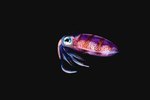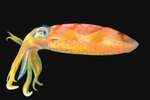
The bottom of the ocean is a mysterious and harsh enviroment. Animals down there have to deal with darkness, extreme cold, and incredible pressure. Yet despite these factors, an estimated 10 million or more species thrive in the deepest depths of the ocean. This forbidding realm supports the largest ecosystem on Earth, including the plunge of the Marianas Trench, in the Pacific more than 37,000 feet below sea level.
Adaptations
Because food is harder to come by in the deep sea, many of the creatures there have evolved novel ways to find and attract food. One adaptation is bioluminescence, the ability of living things to produce their own light. Glowing animals can attract unsuspecting prey. One example is the anglerfish, whose glowing, fingerlike appendage is positioned right above his hungry mouth.
Hunting in the Dark
Some fish rely on senses beyond sight. In the darkness of the Marianas Trench, a fish called the rattail has an extremely sensitive sense of smell. The fish uses scent, rather than sight, to steer toward food. Once it's near food, the rattail uses a special organ on the bottom of its chin to guide itself by feel.
Marine Snow
One staple of the deep sea diet is "marine snow," flakes of organic, edible substances that sink down from the upper ocean. Animals at the ocean's bottom find sustenance in everything from the bodies of dead creatures to fecal matter. Marine snow is diverse enough to support numerous species. For instance, several species of snails and worms feed exclusively on deceased whales.
Microorganisms
The deep sea is an intricate ecosystem, and even the ocean floor itself plays a part. Hydrothermal vents are cracks in the sea floor where erupting magma mixes with ocean water to produce plumes of hot, sulfur-rich chemicals. Some microbes can use these chemicals for energy, sustaining their existence and that of the animals who depend on their roles in the deep sea food chain.
References
Photo Credits
-
Karl Weatherly/Photodisc/Getty Images
Writer Bio
Chloe Newkirk is a writer based in the San Francisco Bay Area. She has been a freelance writer for over five years, and written for a variety of publications. She is a graduate of St. Edward's University in Austin, Texas. Her areas of expertise include crafts, pop culture, the arts, pets, American history and food.




